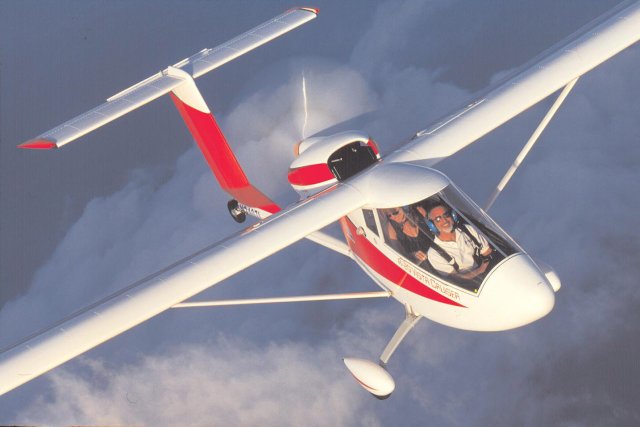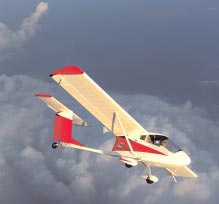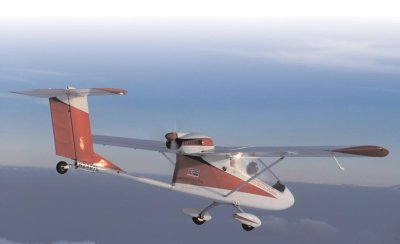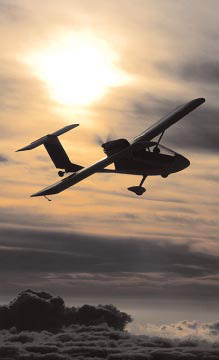


The Vista Cruiser is one of the most enjoyable machines I’ve flown in a long career of sampling numerous light flying machines.

The Vista Cruiser’s sailplane feel comes partly because you sit several feet out in front of the wing.

While the Vista Cruiser looks like a more traditional airplane, it’s flight characteristics can match those of a modern ultralight with good low and slow speed handling, while still offering a pleasant 115 mph cruise. The Ukrainian-designed aircraft features a fiberglass fuselage, metal wing with fabric-covered flaperons, composite landing gear, and all-metal tail with the exception of the fabric-covered elevator. The fully enclosed canopy can be replaced by a windscreen for warm-weather, open-cockpit flying.

The Vista Cruiser we flew for this flight report was powered by a 100-hp Rotax 912S engine; however, the various Vista models will fly well with engines from 50 to 100 hp. The nicely cowled engine gives a sleek and clean look to the aircraft and helps provide less disturbed air to the propeller.

The wide composite landing gear offers good, stable handling characteristics.

With both occupants seated well forward of the wing, the Vista Cruiser offers the feel of a sailplane. A step on the side of the fuselage facilitates entry and exit from the cockpit. Note the cap at the back of the canopy, which provides sun shielding for the pilot and passenger’s heads.

While the instrument panel area isn’t expansive, it offers plenty of room for required instruments. The use of a digital engine instrumentation system helps keep the panel clean.

John Hunter welcomes visitors to Spectrum Aircraft’s offices on Sebring Airport in Sebring, Florida.

Inside the Aeroprakt Ltd factory. One work area houses all the equipment needed for composite work-note the oven at the rear of the room.

The company’s engineers, many of whom previously worked at the Soviet Antonov factory, are located in the office area.

Eastern European designers deliver nimble machines
UPDATE–November 2008: According to FPNA, an American company with a business relationship to A-20 producer Aeroprakt, the A-20 has been discontinued. Please contact FPNA for more information (contact info at end of article).
As the new millennium got underway,
visitors to EAA
AirVenture Oshkosh 2000 examined
a new aircraft from a
Ukrainian company called Aeroprakt
Ltd. Named the A-22 Valor, the unique
side-by-side two-seat aircraft had a distinctive
cabin largely covered in clear
plastic. It was displayed by John Hunter
and his company, Spectrum Aircraft.
The Valor has turned out to be only
the first in a fleet of light aircraft that
have materialized before American eyes.
In 2001, another Aeroprakt model appeared
on Spectrum’s display space-the
A-20 Vista Cruiser, one of a series of A-20
models.
John Hunter became well
known in the light plane
world while working
for Phil Lockwood,
designer of the much-admired Air Cam.
Under the Leza-Lockwood banner, John
flew the Air Cam all across the country in
an ambitious marketing campaign that
exposed the twin-engine, ultralight-like
aircraft to many aviation buffs.
After leaving Leza-Lockwood, John
linked with the Dubai-based group Gulf
Air Technologies, which had contracted
with Aeroprakt to develop a line of lightweight
twins and other aircraft. Spectrum
Aircraft became Gulf Air/Aeroprakt’s partner
for North American sales.
Aeroprakt was formed in 1991 as the
Soviet empire collapsed. Since then, it
has built an impressive catalog of designs
while simultaneously honing its skills as
a capitalist endeavor. Aeroprakt has delivered
nearly 100 aircraft and built a new
factory with funding from its Arab fi-
19
Vista
Cruiser
VistaThe &Varlet
A-20
Cruiser
Eastern European designers
deliver nimble machines
nancier. The core of engineers who
formed Aeroprakt once worked for the
Antonov aircraft company, the Soviet
builder of giant aircraft. Like that company,
Aeroprakt identifies its models
with the letter A and a number, an obvious
emulation of the former USSR
aircraft. Acorns don’t fall far from the
tree.
John’s familiarity with the Air Cam
whetted his appetite for twin-engine machines.
And, indeed, Aeroprakt has
proven to be a company capable of designing
and producing several
twin-engine light aircraft. Using the wellknown
Air Cam as a benchmark, John
has promoted the Aeroprakt twins as possessing
remarkable performance,
responsive handling, stable flight characteristics,
and strong construction, but this month we’ll focus on a couple of the
company’s single-engine light aircraft
that are poised to be contenders in the
upcoming light-sport aircraft scramble.
The A-20 Series
The Aeroprakt A-20 series encompasses
six different aircraft models, which
can get a little confusing at times. The
easiest way to keep them separate is to
recognize that a different engine and
wing configuration denotes a different
model.
The basic A-20 Vista model is powered
by a Rotax 503 engine and has a 37-foot
wing. The Vista Cruiser, which will be the
focus of this report, uses the 912S engine
with a 33-foot wing, and the Varlet,
which also uses the 912S engine, has a
31-foot wingspan. Other models in the A-
20 Vista line are the Vista STOL, Vista SS,
and Vista Super Cruiser.
I don’t mind telling you the Aeroprakt
A-20 Vista Cruiser is one of the most enjoyable
machines I’ve flown in a long
career of sampling numerous light flying
machines.
As always, I examine aircraft I might
fly with a careful eye. I’d noted that the
Vista Cruiser was a fast-climbing machine,
and I assumed other performance
measures would be strong with its 100-hp
912S engine. What I couldn’t determine
from watching the Cruiser fly was its
pleasurable handling and low-speed capabilities.
My initial reaction to the aircraft was
strongly positive, and that isn’t always
the case. Many light aircraft require pilots
to log some flight time in them to acclimate
to their handling characteristics.
The Vista Cruiser proved to climb as
breathtakingly as I expected, and it
cruised quite swiftly, but I didn’t anticipate
the good handling qualities it would
offer at the other end of the spectrum.
For example, I was able to hold altitude
at 50 mph and barely more than
3000 rpm. At this power setting, the Vista
Cruiser was kind to my ears and exceedingly
pleasant to fly. It was also nicely
appointed, and its interior was roomier
than it might appear from the outside.
Inside the Vista Cruiser
An entry step on the left side of the
Vista Cruiser presents one way in, but I
used John Hunter’s technique. He turns
around and hops up on the cockpit frame
and seat back-which are about the same
level-then swings his legs inside. With
feet aimed at the rudder pedals, he slides
down the seat into position. Most pilots
will be able to manage this maneuver;
others can use the step.
Once seated, the Vista Cruiser takes
on the feel of a sailplane. I’m a soaring
enthusiast, so this first impression was
a good one. I found all controls conveniently
located, but these Ukrainedesigned
aircraft don’t follow the standards
used by American engineers. For
example, the Vista Cruiser’s flap lever is
quite different than most American designs.
The lever-or perhaps it should
be called an “arm”-can be accessed
from either the front or rear seats, an
unusual yet very useful feature. This
control slides fore and aft in a track
supported by rollers that provide fluid
movement. You lift the lever up (out of
the detent position) and slide it to a
new position for whatever degree of
flaps you want. Then it convincingly
locks into place.
I didn’t notice much air load on flap
deployment (as I was flying slowly), but
in my first retract experience with the
flap handle, I didn’t maintain a firm grip
and the handle shot forward, slamming
into a fully retracted position before I
could catch it. I was caught off guard, as
many ultralight-type flap handles have to
be retracted with some deliberate if not
muscular effort. Rarely do they exhibit a
spring-loaded action like the Vista
Cruiser’s handle.
Aeroprakt’s designers opted for full-
21
span flaperons, so roll control is modestly
affected by flap deployment. Yet even
with full flaps deployed, roll control remained
quite effective. My Dutch roll
coordination exercises in this configuration
required more aileron movement
than when the flaps were not used.
The Vista Cruiser’s trim lever worked
well. Many ultralights hardly need trim,
but I used trim on the Vista Cruiser as its
powerful engine is mounted above the
aircraft’s center of gravity. Positioned at
the base of the joystick, the trim lever
functioned easily, though I had to stretch
to reach the control. Trim was effective
without being sensitive throughout its
movement range.
A sight-gauge fuel indicator is installed
along the rear occupant’s right side. From
the front or rear seat, it was easy to determine
remaining fuel quantity.
Looking Out
The Vista Cruiser’s sailplane feel comes
partly because you sit several feet out in
front of the wing. With its wraparound
canopy, visibility from the Cruiser is
enormous, even to the rear, although I
had to twist considerably to check the
rudder movements before takeoff. The
canopy has an opaque “cap” inside that
keeps the sun off your head and also
helps to cool the enclosure somewhat.
You might choose Aeroprakt’s topless
windscreen on warm, sunny days. I
would have loved this feature on the
warm day I flew the airplane. John says
the change from the wraparound canopy
to the windscreen only is literally a oneminute
task using removable titanium
pins at two hinge points on the aircraft’s
right side.
Because the summer screen was not
fitted on the Vista Cruiser I flew, I became
busy propping open the canopy
with one hand while working the throttle
and brakes with the other. I really
needed three hands because even at idle
thrust, the potent 912S gently pushed the
Cruiser forward.
Rather reluctantly in the steamy heat
of the day, I worked the canopy lockdown
system. It is very secure and latches
with reassuring authority, but it takes a
little jockeying to position it for latching.
A small cord restrains the canopy when
fully open, and John asked that I make
sure this cord did not get caught when
closing the canopy. On the day I flew the
Vista Cruiser, its single fresh-air inlet wasn’t
enough, so I kept sticking one hand
or the other out to direct more air inside.
Owners in warm climates will want to
add further ventilation.
Once aloft, you can rest your throttle
hand on either the flap linkage arm or on
the aluminum tube linking front throttle
to aft throttle. The Vista Cruiser and Varlet’s
25-inch-wide cabin should prove
sufficiently roomy for most pilots.
No-Doubt Takeoff
Taxiing out for takeoff, I found the aircraft’s
steering authoritative, though on a
crowded airport ramp you might wish for
differential brakes.
I’ve experienced several Rotax 912S
takeoffs when flying light planes, so I
gradually added power to the Vista
Cruiser. The 912S engine provides much
more power than is needed for this aircraft
-remember, it will operate fine on
engines as small as the 50-hp Rotax 503-
but like that stereo system with wattage
you never fully use, many pilots find it’s
better to have too much power than too
little.
Throughout my several touch-andgoes,
I commonly used only 4500 rpm
for takeoff; more is simply excess for a
single occupant. In one takeoff, I used
only 3910 rpm (according to the digital
engine information system John had installed),
and I was still climbing at 500
fpm. No wonder the Rotax 503 can adequately
power the Vista Cruiser! For that
low-power takeoff experiment, I used two
notches of flaps throughout the pattern.
In general, takeoffs were effortless as
long as you didn’t overuse the 912S’s
power. Landings were just as easy but you
must plan ahead. I can sum up landing
approaches in the Aeroprakt with this
comment: I had to use slips on every
landing I made in the Vista Cruiser. I prefer
high approaches, but as I wanted to
do touch-and-goes, landing in the first
third of the runway is wise. Getting the
Vista Cruiser down in the first 1,300 feet
of a 4,000-foot turf strip while using high
approaches demanded a different technique
than landing many slower
ultralights.
However, the Vista Cruiser’s long gliding
quality is certainly not a bad thing.
Should you lose your engine over some
inhospitable terrain, you’ll be very glad
this Aeroprakt model can reach the safety
of those fields you’ve should have kept in
sight. Even when I used full flaps, the
Cruiser wanted to linger in the sky, a fact
most pilots will appreciate.
Fortunately, the aircraft’s authoritative
handling and generous side area made
for highly effective slips that allowed me
to angle the airplane 30 or 40 degrees to
either side.
My early slip trials produced a sink
rate beyond 1,000 fpm, good enough for
most situations where you want to get
the Vista Cruiser down on a short runway.
More experience will help you make
even slower approaches, but moderate
slips and flaps worked well together.
In later slips I applied so much slipping
force that I actually had to brace
myself in the seat; I recorded a descent
rate of 1,800 fpm. With good technique
and some practice, short field or emer-
23
gency landings won’t present problems.
The steepest of my slips were done with
no flaps.
One criticism I have focuses on the
close proximity of the flap handle to the
throttle handle. During final approach,
you may sometimes feel for the knob you
want. You can learn the difference between
the specially shaped handles
designed for tactile feel, but at first I
grabbed the flap handle thinking it was
the throttle. Keeping your hand on the
throttle on final approach, as most instructors
advise, solves the dilemma.
Crisp Control Qualities
One distinguishing feature of all the
many Aeroprakt designs appears to be
the common use of a large tail volume.
Certainly, the Ukrainian designs are not
alone in this characteristic, but I felt the
big tail accounted for some of the superb
handling qualities experienced in the
Vista Cruiser. After performing various
evaluation maneuvers, I can attest to its
fine handling characteristics. All movements
were fluid and light while still
providing some feedback. The ailerons
and rudder seem beautifully harmonized.
I nearly always use Dutch rolls to discover
the basics of handling a new
aircraft; the non-aerobatic maneuver offers
an excellent chance to feel control
authority and harmony. In my first trial,
I did them successfully to 45 degrees each
way-a steep bank that proves handling
is intuitive and responsive.
Later in my test flight, I slowed the airplane
down, deployed full flaps, and
again tried Dutch rolls. This time I had to
limit the bank angles as the flaperons
consumed some of the aileron range, although
I was still able to bank back and
forth 30 degrees in a ball-centered fashion.
By bringing the flaps back up and increasing
my speed to about 50 mph,
Dutch rolls once again became very light
and easy to do. The aileron range shortfall
experienced with full flaps went away
and the coordination improved. Pilots
rarely do Dutch rolls with flaps fully extended,
but doing so will identify control
effectiveness at slow, approach-like
speeds.
The Vista Cruiser flew so well-so like
an ultralight-with full flaps that I spent
an unusual amount of time in this configuration.
At 50 mph, I found surprisingly little
adverse yaw. Once banked without rudder
the nose comes around to the desired
direction quite quickly. In this regard, the
Vista Cruiser was superior to most ultralights
I’ve flown.
Full power stalls never broke, even
well down into the low 40-mph range. A
distinct buffeting tells you you’re slow-
you’d have to be asleep to miss it. Down
into the high-30s, power-off stalls did
break modestly, and Vista Cruiser became
somewhat neutral laterally during
the highest deck angles.
My evaluation of push- or pull-andrelease
from level flight showed a neutral
longitudinal stability that tended to decay
very slowly. With only myself in the
front seat, the Vista Cruiser did not fully
recover to level flight without input.
The high thrust line placement of the
engine was one influence. I did not feel
any uncertainty with this characteristic,
but it did hunt somewhat in gentle
pitch oscillations.
Giddy Up
Though one day I look forward to flying
a Rotax 503-powered Vista, I have to
admit to a lot of excitement about experiencing
the Rotax 912S. With this engine,
the Vista Cruiser is a climbing wonder; I
saw a sustained 1,700 fpm rate. The
Cruiser, as belies its name, also cruises
fast, but power isn’t only for speed and
climb.
At the other end of the spectrum, I
was also able to fly low over open fields
while using full flaps at power settings as
low as 3200 rpm and at speeds in the
higher 30-mph range. This is a wonderful
demonstration from an aircraft that can
also zoom to 120 mph. In one maximum
power run, I didn’t trim the nose down
enough and gained 700 feet, yet I still
saw a 115-mph indicated airspeed.
Backing off the throttle, I used 3800
rpm, which produced about 60 mph. At
this setting, the Vista Cruiser could stay
aloft a long time. At more than 100 mph,
you feel the bumps more noticeably;
flight in the 50-70 mph range is
smoother.
At a mere 3400 rpm, I saw 42 mph
while staying fairly level. Though Vista
Cruiser looks quite different than most
American ultralights, it can clearly fly as
slowly as many ultralight designs. Operating
at low power settings made for a
very quiet cabin.
With the throttle near idle thrust
(about 1750 rpm) and at about 50 mph,
the Vista Cruiser produced a descent in
the 300-500 fpm range. The measurement
was inexact as the day was full of
convective lift, but this slow a sink rate
compares to all ultralights I’ve flown. I
flew at well under the aircraft’s 1,000-
pound gross weight, which obviously affects parameters like sink rate, yet the
Cruiser’s descent was so slow I was
tempted to shut down the engine and try
some soaring. Glide and sink rate are superior
to most other machines in this
class.
For those who don’t care about slow
speed flying or soaring flight, the 912Spowered
Vista Cruiser is an excellent
cruiser. It can zoom to a VNE of 143 mph
and can easily sustain 115-120 mph. The
A-20 Varlet that Spectrum Aircraft has
also begun importing can do even better,
reaching 132 mph on shorter 31-foot
wings, thus both models are candidates
for the proposed light-sport aircraft (LSA)
rule.
At the other end of the spectrum, fortunately -as sport aircraft aren’t always
driven from Point A to Point B-I found
the 912S-powered Vista Cruiser to be lots
of fun at the low-over-the-field flying,
which I consider an essential light aircraft
attribute. Using full flaps and after practicing
slow flight at a higher altitude, I
was able to drift lazily over my favorite
Florida fields at around 40 mph.
One of Your Own?
Anyone who experiences flight in it
may fall in love with Aeroprakt’s A-20
Vista Cruiser. Its great aerodynamic efficiency
and its hard-working wing should
impress just about any pilot.
Buying a Vista Cruiser, however,
means you need to spend some time with
John Hunter. Aeroprakt makes so many
design variations of the A-20 series alone
(plus numerous other models of interest)
that you may have trouble deciding
which model is right for you. I’ll give
some information, but a call to Spectrum
is necessary.
The aircraft I flew was the A-20 Vista
Cruiser, but since that evaluation Spectrum
has started importing the
cantilever-wing A-20 Varlet. John says the
Varlet was developed specifically for the
proposed LSA rule.
In the three years since the A-20 series
was introduced to the United States market,
the series has seen a few design
changes. For LSA, the wingspan has been
reduced to 31 feet from 33.4 feet to assure
it can reach the maximum speed allowed
under the proposal: 132 mph versus 115
mph in the longer-winged version. With
the shorter wing, stall also rises but by a
very small amount-perhaps from 36 to
39 mph depending on airspeed indicator
accuracy. Buyers who don’t care about
hitting the maximum LSA speed limit
can select a longer wing for superior slow
speed performance; Aeroprakt makes a
37-foot span wing for the A-20 Vista
model in the series in addition to the
33.4-foot version I flew.
With its 100-hp Rotax 912S, the A-20
Vista Cruiser sells for $42,500, while the
Varlet sells for $48,000 as a “quick-build
final assembly” kit. Because Aeroprakt
has always performed a generous amount
of factory pre-assembly, you can be sure
the most challenging parts have been
professionally done. Buyers are typically
left to do the time-consuming tasks that
make up the 51-percent portion for the
experimental amateur-built rule, but
these tasks don’t commonly require great
precision. To be sure how your A-20 can
meet United States regulations, you’ll
need to discuss the final configuration
with John.
Nearly $50,000 is certainly more than
some American designs will sell for, but
the Vista series comes well equipped. For
this money, you get the 100-hp Rotax
912S, a three-blade composite prop, electric
starting, altimeter, airspeed indicator,
vertical speed indicator, digital engine instrumentation,
the “hardtop” canopy,
wheelpants, all fabric work, and factory
paint. The price tag does not include
shipping.
Before you get too deeply into kit or
ready-to-fly purchase options, I recommend
you arrange a flight with John.
Unless I miss my guess, most pilots will
truly enjoy a flight in the A-20 Vista
Cruiser or Varlet.
| Seating | 2-place, front and back |
| Empty weight | 535/515 pounds |
| Gross weight | 1,000/1,000 |
| Wingspan | 33.4/31 feet |
| Wing area | 151/140 square feet |
| Wing loading | 6.6/7.1 pounds per square foot |
| Length | 22/22 feet |
| Height | 5.9/5.9 feet |
| Kit type | Quick-build available |
| Standard engine | Rotax 912S/Rotax912S |
| Power | 100 hp/100 hp |
| Power loading | 10.0/10.0 pounds per hp |
| Max Speed | 115/132 mph |
| Never exceed speed | 143/180 mph |
| Rate of climb at gross | 1,200/1,400 fpm |
| Takeoff distance at gross | 200/280 feet |
| Landing distance at gross | 250/300 feet |


Leave a Reply